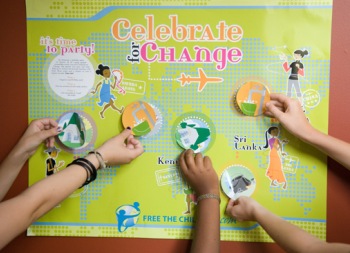Developpement internationale - Top 10

Photo: FreetheChildren.com
Are you teaching about international development and social justice issues? Here are 10 organizations who have developed material to help educators and students learn more about our global community. Be sure to also check out the Canadian International Development Agency Youth Zone for more about Canada's history and role in helping the world.
UNICEF’s Global Classroom allows teachers, students, and parents to come together to further their understanding of international development and to get involved in the global community. Teachers will find elementary and secondary level lesson plans, newsletters, as well as Canadian curriculum links.
MoveYourWorld.Unicef.ca is the interactive student website, and features videos, games, podcasts, and wikis for students looking to further engage with global issues and causes.
The United Nations Association of Canada, which aims to increase awareness about the important activities of the UN, has a number of educational programs available to students and teachers. Some of the topics explored through their programs include peacekeeping, disarmament, and refugees. Teachers will find background information and content, resource guides, and curriculum links. A useful e-library provides a few additional resources, manuals, and toolkits.
World Vision Canada is a Christian humanitarian organization, and one of Canada’s largest relief and development agencies. OurWorldClass.ca is their interactive website for K-8 educators wishing to teach their students about global citizenship. Classes can participate in Take Action Projects, which provide resources and lesson plans, as well as a dedicated virtual space to showcase your work and interact with other participants.
The Canadian Red Cross has a long history of dedication to emergency response, preparedness, and disaster relief, both at home and abroad. Through a variety of educational resources, including in-class workshops, teachers and students can explore issues relating to natural disasters, poverty, disease, and war. RedCrossforYouth.ca is their youth website, which allows young people to learn more about the Red Cross, get involved with local and global causes, and connect with other youth who are doing the same.
Oxfam Canada is a member of the international confederation Oxfam and dedicated to ending global poverty and injustice. Oxfam Canada provides ready-to-deliver workshop materials, presentations, and lesson plans for educators. With these interactive and simulative materials, students can engage with issues relating to trade, globalization, labour conditions, and food security.
Founded in 1995, War Child Canada is an award-winning non-profit organization, dedicated to helping and empowering war-torn communities. Their youth site, GetLoud.ca, showcases the support War Child has received from Canadian musicians over the years, while inspiring youth to get involved in humanitarian causes. Students can explore the issues, read first-hand experiences in “Voices From the Field,” join discussion boards, and participate in social action initiatives. Educators will also find lesson plans, manuals, and curriculum connections.
Founded in 1996, the Media Awareness Network (MNet) aims to support media literacy and digital literacy in our schools. Comprehensive educational packages include lesson plans, articles, worksheets, and evaluation rubrics. There are several lesson plans and activities on Media and Global Development, which allow students to analyze media portrayals of developing countries and to learn more about international relations.
The Ryan’s Well Foundation is a Canadian charity that emerged from 6 year old Ryan Hreljac’s dedication to bringing clean water to developing countries. The Ryan’s Well Foundation has developed the Youth in Action program to help educate students about the importance of clean and safe water, while empowering them to become informed and active citizens. A number of downloadable lesson plans and resources are available to students and teachers wishing to participate in the program.
Founded in 1995 by 12-year-old Craig Kielburger, Free the Children is a largely youth-run non-profit organization, aimed at alleviating child poverty and exploitation. The organization’s success is in and of itself a great lesson on the importance of involving youth in social action. At FreetheChildren.com, youth can read blogs, participate in campaigns, and download resources to help them plan events, fundraise, start their own club, and raise awareness. Teachers will find comprehensive lesson plans, handouts, bibliographies, and tool-kits.
Kiva is an innovative, non-profit organization that allows individuals to send microloans to entrepreneurs in developing countries. The loans — which can be as small as $25 — are repaid to the individuals, who can then decide to reinvest the loan in a new borrower, or withdraw the money. By using Kiva in the classroom, students can learn about microfinance, gain a better understanding of other cultures and countries, and become empowered to make a real difference in the world. While Kiva has not developed their own educational material, their website contains testimonials, videos, articles, and guides from other teachers who have used Kiva in the classroom.
Related Content
Classroom Resources
Lesson Plans